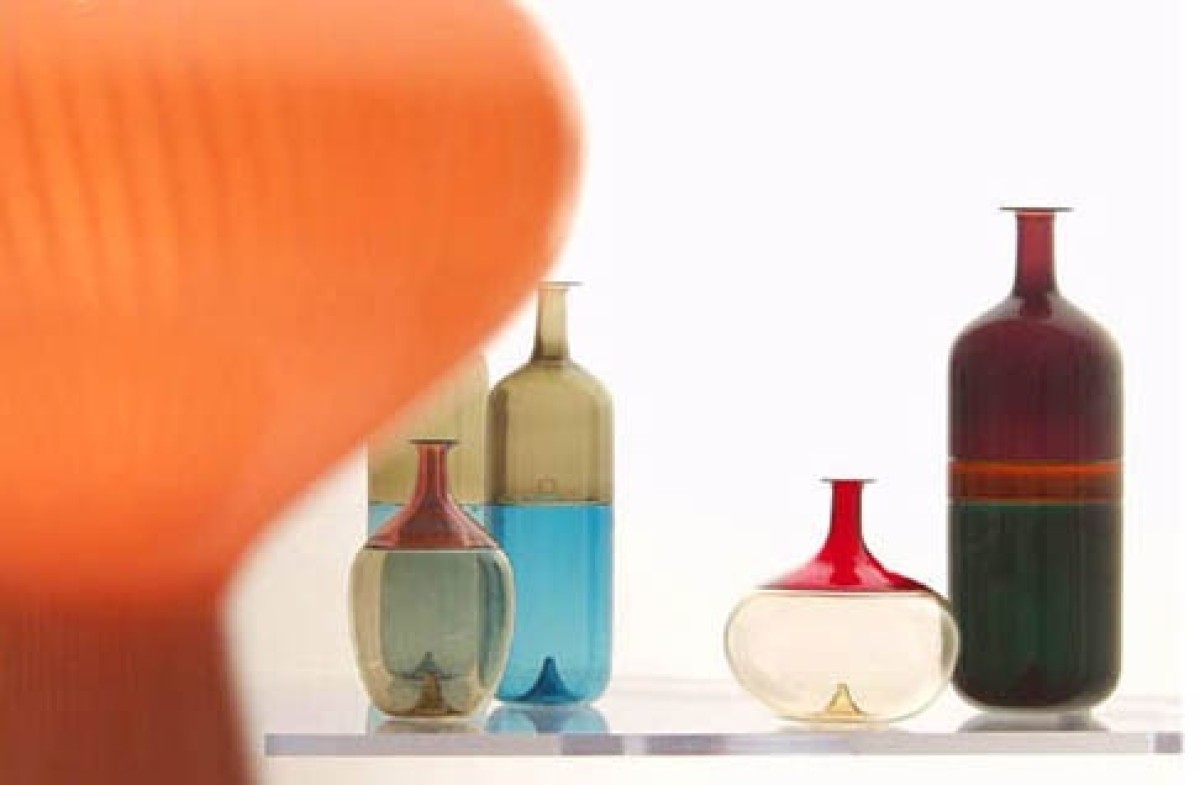Glass has been a medium of creative expression for nearly 5,000 years. This exhibition centered on art glass from the Venini factory in Venice, Italy (founded in 1921), shown in a context of glass from many other centuries and cultures — Ancient Egyptian, Pre-Roman, Roman and Islamic glass, European and American glass from the seventeenth to the twentieth centuries, nineteenth century Chinese snuff bottles and twentieth century glass from Mexico and Japan. A special feature of the exhibition was an installation of glass by Dale Chihuly in the Cornell Rotunda.
Playing continuously in the Audio / Visual Room adjacent to the exhibition were the films “Chihuly over Venice” and “Chihuly and the Masters of Venice.”
The discovery of the use of fire to make glass by melting inorganic substances of the earth such as silica sand, borax, soda and lead is attributed to the third millennium B. C. in Mesopotamia – the cradle of civilization. Glass from this era has been discovered in Egypt and Babylon.
Glass melted onto the surface of clay became known as glaze, and glass melted onto the surface of metal became known as enamel.
By the third century B. C. many techniques had developed for making glass beads, small bottles and bowls – knowledge of which was carried throughout Europe and the Middle East with the spread of the Roman Empire.
By the fifteenth century Venice had become the world center for the mass-production of this precious material including beads that were shipped throughout the world. Early American colonists traded Venetian glass beads for the furs of American Indians who quickly used these colorful “trade beads” for creating magnificent clothing and adornment, as did the tribal peoples of Africa.
Then In 1921, Paolo Venini, a lawyer from Milan with a passion for glass and a talent for business, founded his glass factory with Venetian Giacomo Cappellin, bringing fresh design ideas to the Island of Murano, the home of Venice’s glass industry. Within two years, the high artistic quality and originality of their glass was recognized at international exhibitions, leading one critic to comment, “Beyond doubt, the art of glass has been resurrected in our country.”
When the partnership dissolved in 1925, Paolo Venini continued to be responsible for a fresh approach that used traditional Venetian techniques. He attracted a variety of talented designers such as Vittorio Zecchin, Carlo Scarpa and Fulvio Bianconi.
In the 60s and 70s the Venini factory played host to an international group of designers including Tapio Wirkkala, Ove and Brigitta Karlson, Thomas Stearns, Dale Chihuly, Richard Marquis, James Carpenter, Michael Nourot, Marvin Lipofsky, Benjamin Moore, William Pringle, John Milner, and more recently, Toots Zynsky and Tina Aufiero.
The third generation of the Venini family in Venice, Laura and Alessandro Diaz de Santillana, continues the family tradition as internationally recognized, independent glass artists. They are children of Paolo Venini’s daughter, Anna, and her husband, Ludovico Diaz de Santillana, who continued the direction of the family’s business after Paolo Venini’s death in 1959 until the business was purchased by the Gardini and Ferruzzi families in 1986. They continue the Venini name and practice of creating glass with the participation of international designers.
The Venini Collection curated by Anna Venini Diaz de Santillana
Exhibition sponsored by Barbara Joy Marriott-Wilcox.
The exhibition was organized in collaboration with the Museo ItaloAmericano of San Francisco (where it was on exhibition from January 15-April 29) and The Italian Cultural Institute of Los Angeles. It has been assembled with loans from Anna Venini, Venini S.p.A., The Corning Museum of Glass and private collections in Italy and the United States of America.
Accompanying the exhibition is VENINI -- Catalogue Raisonne, 1921-1986 by Anna Venini Diaz de Santillana.
FINALE to VENINI – GLASS & DESIGN – in a World Perspective, held on January 5, featured a concert by Bryan Verhoye playing piano interpretations of the exhibition and an illustrated lecture by Dale Chihuly.
